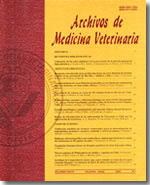Atypical phenotype of Vibrio ordalii, a highly pathogenic bacteria isolated from Atlantic salmon reared on the marine coast of southern Chile
Main Article Content
Abstract
During the winter and spring of 2003, Atlantic salmon (Salmo salar) reared a sea farms along the marine coast of southern Chile, were affected by outbreaks of disease. The pathological analysis of the affected fish were characterized by the presence of skin lesions, haemorrhaging ulcers and mortality, while the internal signs included pericarditis, peritonitis, multiple necrotic foci in the liver and signs of systemic septicaemia. In all cases, pure cultures of bacteria were isolated from the lesions and internal organs. The isolated bacteria were characterized by means of conventional bacteriological identification assays, and a Vibrio sp. was suspected to be the agent of the disease. The final identification of the bacterial isolates was made after amplification and characterization of the 16s rRNA of the isolates using polymerase chain reaction (PCR), followed by comparison of the nucleotide sequence with previously submitted bacterial 16s rRNA sequences from a gene bank. According to the results of the analysis, the agents producing the disease were bacteria that belonged to the Vibrio ordalii group. However, the dissimilarities discovered by using the morphological, physiological, biochemical, enzymatic and antigenic assays did indicate important differences from the reference strains of V. ordalii. Forthis reason it is suggested that the Chilean field isolates of V. ordalii could be considered as an atypical biotype and/or phenotype of V. ordalii,although more comparative studies between the complete genomes of these bacteria are required.

